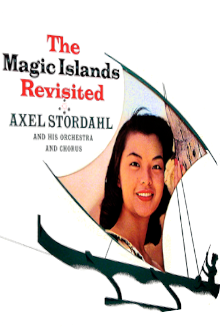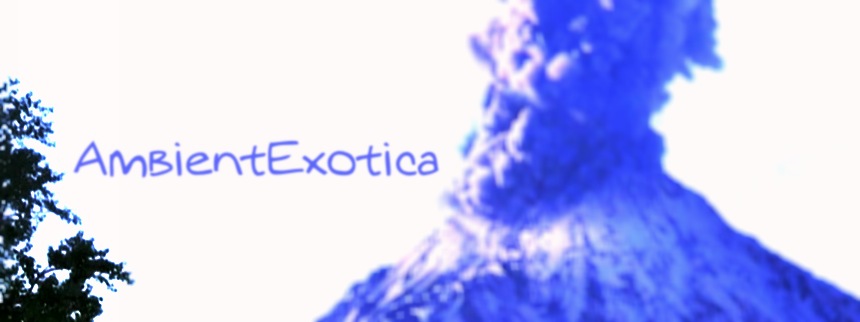
Axel Stordahl
The Magic Islands Revisited
1961
Another review, another album about Hawaii, one amid hundreds of records created to cash in on the Exotica craze and in order to celebrate the latest US-state. But things are auspiciously different in the case of The Magic Islands Revisited, the third Exotica LP of arranger, songwriter and trumpeter Axel Stordahl (1913–1963). It is recorded in Hollywood and released in 1961 on Decca Records. After his travelog Lure Of The Blue Mediterranean (1959) and the jungle greeneries of Jasmine & Jade (1960), the third time's the charm, at least partially so: The Magic Islands Revisited is Stordahl's first album to include a mixed choir which is used in six of the 12 tracks, not always to great success, for some of the material is really – and I mean incredibly – kitschy and syrupy, but I do not care all too much about these missteps, as there are many instances where this album shines in blazingly dazzling colors.
The orchestra strings gleam and are truly rooted in the Space-Age subgenre, the instrumental pool is large and comprises of harps, flutes, horns and other reeds, the percussion side is unexpectedly exotic for such a seemingly clear cut Easy Listening record thanks to its bamboo rods, bongos, maracas and shells, and did I mention the prominent inclusion of birdcalls, a feature that was heretofore amiss in all of Stordahl's LP's? I'm definitely more than a bit hooked by this admittedly flawed work which is torn between gimcrack and a truly great Hollywood string-fueled euphony, truthful excitement and saccharine lullabies, classic instrumentals and Pop-oriented vocal commissions. And heureka, The Magic Islands Revisited has finally been digitally re-issued in October 2012, but more about this and all of its 12 tracks below.
Say what you will, but the song title alone is always loaded with pure joy: Stordahl’s instrumental take on Dimitri Tiomkin’s and Ned Washington’s Return To Paradise opens side A in a great fashion with vivid birdcalls – the superior ingredient of exotic records – and moves on to shuttle between mesmeric string washes, allotted piano droplets, the beautiful glissando of pristine harps, a soothing alto flute which plays the main melody and evokes the atmosphere of a hidden cove, and best of all, there is a stylistic remainder that is normally exclusively found in quartet records, namely chinking tambourins and triangles, both of which are placed in the spotlight! Instead of simply accompanying the mélange in the background, this percussive aorta is prominently meandering and boosts the intimacy despite the many dozens of strings. This is a pitch-perfect start, taking the best bits from symphonic Exotica and its jazzier next of kin.
Mel Peterson’s E Naughty Naughty Mai Nei is next and changes the mood decidedly, for it is less paradisiac and more gleeful. It is based on a swinging groove, the mixed choir oscillates between all-male and all-female vocal sections or echoes respectively, with the polyphonous flutes and comprehensive string sweeps expanding the majesty in the right doses. At its heart, E Naughty Naughty Mai Nei is a lightweight Pop song, and Axel Stordahl underlines its nature perfectly and does not succumb to pompous segues.
While Paradise by Nacio Herb Brown and Gordon Clifford returns to utterly cherubic structures which are supercharged with another flock of birdcalls, effervescent string cascades, a serene bass flute, glistening sunlight-reflecting glockenspiels and silkened horns whose streamlined nature luckily does not tear the resplendent setting apart, it is Jack Owen’s famous Hukilau Song which is tremendously warmhearted, choir-fueled and rose-tinted, its percussion residing in rather conventional climes, but what it lacks in exotic percussion, it literally unleashes with the help of magnanimous Hollywood strings, and that is the snugly feelings of shelter and exhilaration. The uptempo arrangement furthermore succeeds in letting the catchy melody shine all the more via the textural supremacy of the violins, making Stordahl’s rendition one of the best orchestral ones.
My Tani, originally written by August Goupil, Dick Gump and Johnny Noble, broadens the spectrum with a revved up dose of yearning, for the strings are now screeching spectrally in adjacency to dusky but mellow brass bursts, glittering wind chimes and an almost military march-like staccato use of tambourins, bamboo rods and goblet drums. The slightly cloudier than usual soundscape opens up in the latter half though, with the brass instruments being played in a smooth legato way and joined by cherubic flute driblets and piano chords. This tune is as complex and multilayered as Easy Listening can get. Side A closes with Charles E. King’s and Milt Raskin’s Forevermore, and it is here where Axel Stordahl goes all-in on the Hapa Haole movement. Sure, the strings reveal the orchestral dimensions, but the languishing choir in tandem with the downtempo make this an overly sugar-sweet ballad with not even one sliver of coolness or exotic cheekiness attached. I love romantic mélanges of soothing bittersweetness, but this one is a downer, I’m afraid.
Side B starts in a gorgeous fashion and even outshines the opener Return To Paradise of side A: Axel Stordahl’s own composition Return To The Magic Islands which he co-wrote with longterm collaborator Henry Beau is presented, and proudly so, for this is a Space-Age artifact with a bold Exotica injection. The strings have Les Baxter-like proportions, they whirr and whirl in a warped manner, totally transfiguring the scenery. Of equal importance is the thick and upfront percussion section with a multitude of ingredients such as maracas, bamboo rods, emery shells and bongos. The song is also surprisingly energetic due to the middle section being loaded with pizzicato strings and staccato trumpets. The ensuing holes in the structure allow short outbursts of percussion prowess. The permanent shifts between the lachrymose susurrations and vigorous eruptions let this dedicated song tower above the Easy Listening competition, making it Stordahl’s strongest contribution devoid of any kitsch.
The next track is an interpretation of Jay Livingston’s and Ray Evans’s Frangipani Blossom, and the sizzling maracas as well as the plinking tambourin underlining work marvelously well and are desperately needed, for the choir and the strings make this another syrupy, poeticizing ballad; on the plus side, Stordahl refrains from making a melodrama out of this devoted flower song.
The following I Will Always Love You by Helen D. Beamer and Tony Todaro is a welcome inclusion. Fans of Exotica bandleader Gene Rains know this tune off his final part of his exotic triptych Rains In The Tropics from 1962. It is nice to encounter a symphonic version of this song. And it is a really enchanting version, especially the spacey flute washes, the downwards spiraling harp sections and the technicolor violins elevate this kitschy love ballad and make it an unexpectedly strong tune that obviously floats in romantic waters, but is tastefully constructed. Leon Pober’s and Harry Kalapana’s Song Of Old Tahiti is another Pop-infused artifact of this LP, with the original lyrics fully intact and sung by the mixed choir. Superb doo-doo chants remind of Juan García Esquivel’s Space-Age legacy, and theremin-like strings only add to this impression. The intimacy and mimicry of a quartet arrangement are interpolated by the focus on the percussive side – the maracas, shells and tambourins are again in the foreground.
Moving into much more celestial zones, Sonny Burke’s and James Benson Nablo’s The Bamboo Is Bending lures the listener with languorous fully fleshed strings, silky horns and rare vibraphone glints. Living up to the song’s title, bamboo rods make up an important ingredient, with the bass flute playing the lead melody that works enormously well in front of the large backdrop of sweeping strings. The closing track is the fitting Farewell by Jack Brooks and Eddie Lund, and it is basically the Aloha Oe of this album: the male choir melts along to the sugar-bolstered string concoction, the mixed choir offers a maximum of yearning, and only the gyrating flute melodies offer a bit of variety. I usually ignore this one, and since I re-listened to it in order to write this review, I know exactly why I avoided it for so long.
The Magic Islands Revisited is a superb Exotica album, and while there are people who deny Stordahl the status of a real contributor to the genre (for his albums are symphonic, not jazzy), this album has all the ingredients that make exotic records so flamboyant and mellow, be it the many song-opening birdcalls, the golden-shimmering harp infusions or the simply wonderful string coatings that coalesce marvelously with the exotic percussion placentas on many tracks. The mood is incessantly blissful, with whimsical traces of yearning and more perceptible scents of adventure wafting through the air. The mixed choir is, as it turns out, Axel Stordahl's biggest coup as well as the major flaw on many a composition: the ladies and gentlemen either add much enchantment to an arrangement or take away large portions of the magic, the latter of which has surely not been intended by the arranger with Norse roots.
I tend to think of myself as humbly open-minded and all too embracing when it comes to Exotica music; I count Easy listening works to the genre, I place spacey orchestrations in close vicinity etc., but mind you, the choir teaches me about my limits! My Tani, Frangipani Blossom and Farewell were soaked in a syrupy gallimaufry and are still moist to this day. Songs and performances like these are perfectly fine on their own and I know that there are many fans out there who enjoy the romance of them, but the amount is too much for my ears.
What these songs lack in taste, Axel Stordahl accomplishes with the vivacious selection of cuts such as the paradisiac duo Paradise and Return To Paradise, as well as The Hukilau Song, Stordahl's own Return To The Magic Islands or the equally dreamy The Bamboo Is Bending. In its best moments, Stordahl's third Exotica LP is enormously lofty, enlightening and even Space-Age-evoking. In its worst instances, it is hyper-kitschy and more than a tad corny. T
he good parts and songs outweigh the bad ones by a wide margin, and thus I consider The Magic Islands Revisited a superb album that is on par with similar choir-focused works such as Dominic Frontiere’s Pagan Festival (1959), Stanley Wilson’s Pagan Love (1961), Stanley Black’s Exotic Percussion (1960), Warren Barker's Hawaiian Eye (1960) or Werner Müller’s Hawaiian Swing (1962) to just name a few examples that altogether build the melting pot of the symphonic Exotica genre. Stordahl's third album has recently been digitally re-issued in October 2012 by Smith & Co. and is available in all digital music stores. Unfortunately, the above foldout/gatefold front artwork has been exchanged with a generic one that depicts surf boards (!), but this flaw does not have any effect on the music itself which has been skillfully remastered. In any way, Axel Stordahl delivered. Wholeheartedly recommended.
Exotica Review 193: Axel Stordahl – The Magic Islands Revisited (1961). Originally published on Mar. 16, 2013 at AmbientExotica.com.
